Butterfly valves have applications in various areas such as vacuum services, compressed air or gas operations, suspended solid services and many others. Whether functioning as control or shut-off valves, they play a major role in most industrial operations.
Butterfly valves have replaced the ball valves in industries (especially petroleum) and are preferred to gate valves because of their throttling function, simple operation, and ease of maintenance.
The selection of a butterfly valve requires adequate knowledge of its types and their functions in different conditions and various other factors that influence the selection of the suitable valve.
This post discusses all you need to know about a butterfly valve, including its definition, parts, functions, and types.
What Is A Butterfly Valve?
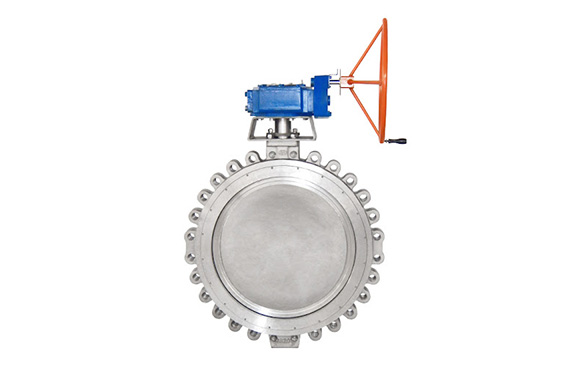
A butterfly valve is a machine that rotates its disk by a quarter-turn to allow or restrict the flow of media within the diameters of large pipes. The butterfly valve has a rod and a disc. The rod passes through the disc into an actuator which regulates the movement of the disc, rotating the disc either parallel or perpendicular to the flow of media.
The butterfly valve, as the name implies, operates like the butterfly. With the rod of the machine representing the body of a butterfly and the disc representing the wings, the movement of the valve mirrors the movement of a butterfly, with each wing making a 90-degree rotation.
Originally, the butterfly valves were installed where tight seals are not necessary; however, the production of the valves with tight seals made of rubber or elastic materials enabled the butterfly valve to function as a shut-off valve.
While throttling valves, most butterfly valves function as only block valves. They are functional for various media, and due to their lightweight and low cost, they are found in several modulation devices. The main components of a butterfly valve are the disk, stem, seat, and body.
Butterfly Valve Symbol
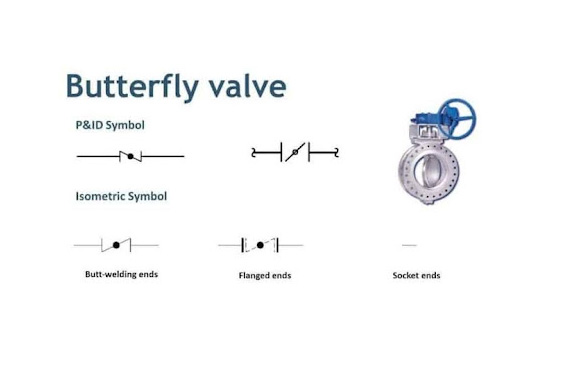
The symbol of the butterfly valve is composed of two vertical parallel lines, with a diagonal line extending from the top of the first line to the bottom of the second line (P&ID symbol).
The two solid horizontal lines by the sides of the vertical lines indicate that butterfly valves are two-way inline valves used for flow control, either on/off or throttling. In the centre of the two vertical lines and the middle of the diagonal line is a solid circle.
Similar to a globe valve symbol with two diagonal lines crossing themselves, the butterfly valve symbol is the only symbol where a full triangle is not used. Isometric symbols are used in isometric drawings.
Types Of Butterfly Valves
Butterfly valve types vary based on their different classifications. They are classified here based on their valve actuators, connection design, and disc closure design.
Classification Based On Valve Actuators
Based on their valve actuation method, butterfly valves can be separated into manually operated valves that use manual handles or gears and automatically operated valves that function using electric, pneumatic or hydraulic actuators.
Manually Operated Butterfly Valves
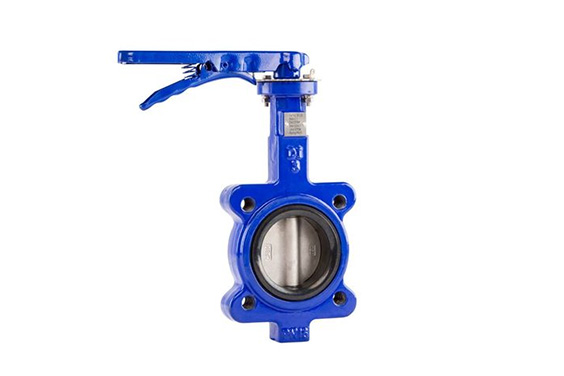
Manual operation of the butterfly valve involves using a hand lever or a gear. This operation is not expensive and is easy to perform.
- Hand Lever: With a handle, the valve is set into an open, partly closed, or fully closed position. Small butterfly valves are usually operated this way. Extended spindle valves can be operated remotely using a long stem.
- Gear: In this operation, a gearbox increases the torque but reduces the movement speed. The Butterfly valves that function with the gear are a bit larger than those using the hand lever.
Manual butterfly valve operations work without the use of power. But they work low speed and cannot be used for critical pipe systems.
Automatically Operated (Actuated) Butterfly Valves
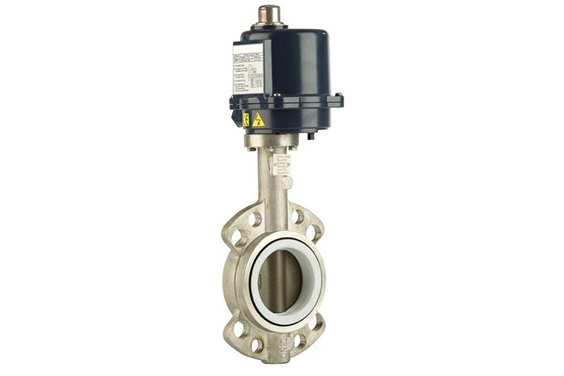
Automatically Operated butterfly valves can be controlled from remote locations. The valve actuators allow for control of larger valves. With an ability to remain open or stay closed if the actuator fails, the actuated valves provide a safe and dependable option. The actuated valves include:
- Electric Butterfly Valves: These valves are remotely operated using a two-directional motor. The electric valve system uses the gearbox found in the manual butterfly valves to increase torque. The installation of these butterfly valves is simple.
- Pneumatic Butterfly Valves: These include single-acting and double-acting actuated valves. It uses compressed air to move the piston, which results in the opening and closing of the disc.
- Hydraulic Butterfly Valves: These also include single-acting and double-acting valves. It uses hydraulic pressure to move the piston to open or close the valve.
Classification Based On Connection Design
Various methods are employed to connect a butterfly valve to a piping system. Common types of butterfly valves based on their connection design are:
Wafer-Type Butterfly Valve
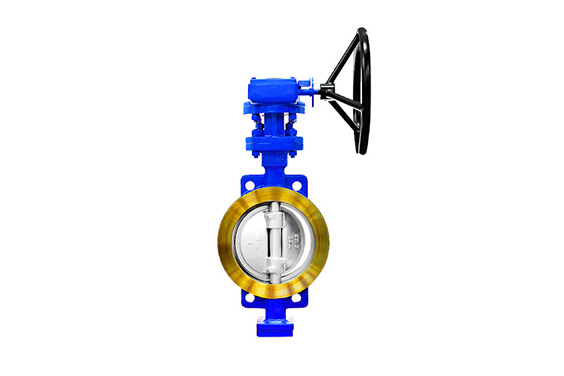
This type of valve offers the most economical option. While placed between two pipe flanges, the wafer-type butterfly valve is designed to seal against the two-directional flow differential pressure of the guild. It restricts any backward flow in the system designed for any unidirectional flow.
Bolts are passed through holes on the body of the two sides of the valves to connect the two pipe flanges. The space between the pipe flanges and the valves is closed using gaskets or o-rings on the two sides of the valve.
Lug-Type Butterfly Valve
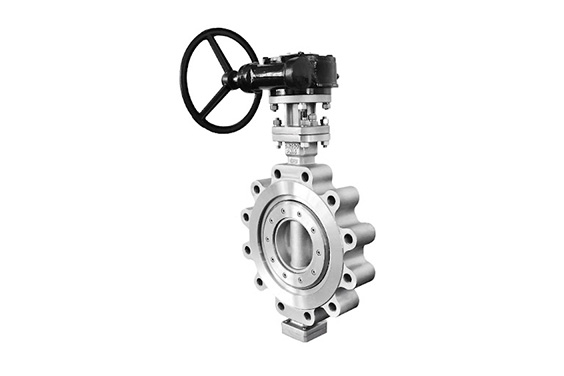
With threads on the outer sides of the valve body, the Lug-type butterfly valve allows a joining of the valve and the pipe flanges with two bolts on each side of the valve.
This setup permits a disconnection of one side of the system without affecting the other side for dead-end service. The lug-type butterfly valve installation for dead-end service usually occurs at lower pressures (75 psi). Still, the installation occurs at a higher pressure (150 psi) when the valve is placed between two pipe flanges.
These valves are insusceptible to solvents and chemicals, and they can withstand a temperature of up to 200-degree Celsius.
Flanged-Type Butterfly Valves
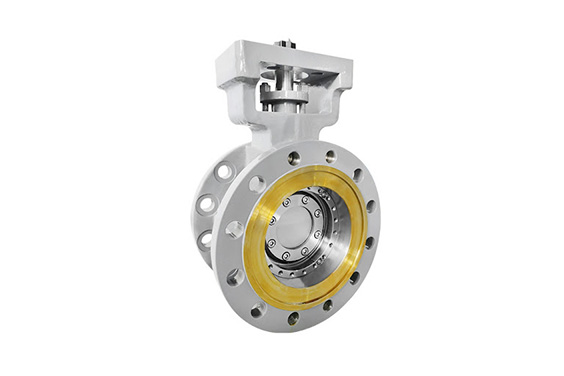
These have flanges at end connections, which makes it easier to be connected directly with pipe flanges. The Flanged-Type butterfly valves are better used in high and low temperatures. Eight bolts join the valve body to the pipe flanges.
Classification Based On Disc Closure Design
Here, butterfly valves are differentiated based on the position of the stem to the disc and the design of the butterfly valve seat. Based on their disc closure design, the types of butterfly valves are:
Concentric Butterfly Valves
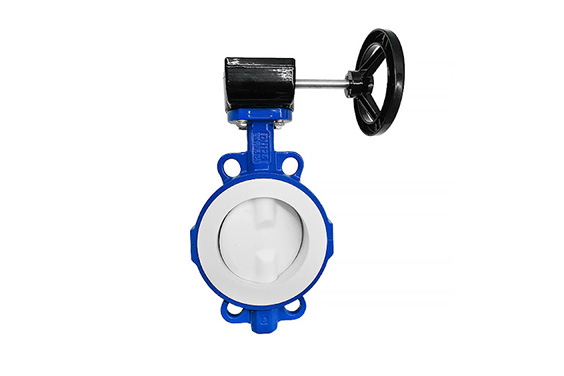
In this type of butterfly valve, the stem goes through the middle line of the disc, and the seat is designed into the valve body. They are called ‘zero offset butterfly valves because the disc does not offset from the stem.
This butterfly valve design depends on how flexible the rubber seat is to seal the valve effectively. This valve design has a low-pressure work rating (reaching 250psi) and can handle temperatures between 0 and 400F.
Eccentric Butterfly Valves
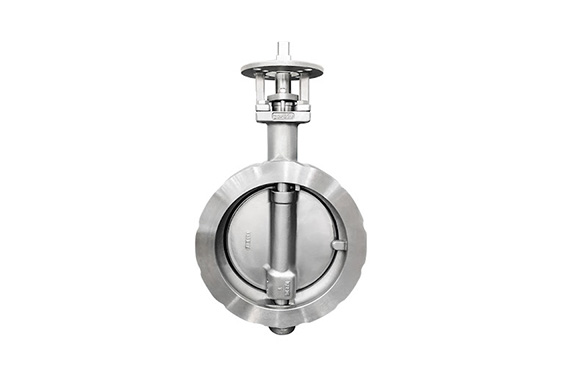
In this butterfly valve, the stem passes behind the disc and not through its centre. A single offset butterfly valve occurs when the stem is positioned behind the middle of the disc.
There are two offsets in a double offset butterfly valve (also double eccentric butterfly valve), with one behind the middle of the disc and another additional offset. Likewise, In a triple offset butterfly valve, there are three offsets, where the last offset is the contact axis of the seat.
Eccentric valve designs (double offset) are also high-performance butterfly valve designs. The valve seals are resilient and do not jam from closing action. They operate at high pressures and do not get destroyed easily.
Butterfly Valve Advantages And Disadvantages
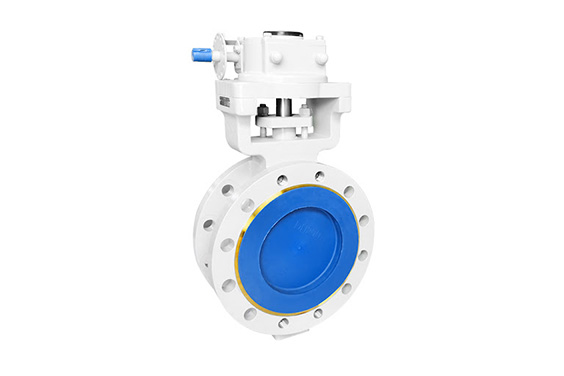
A butterfly valve is a common machine in factories, workshops, or places requiring pipe operations. In these places and for its users, the butterfly valve has various advantages over other valves of similar function and disadvantages that make them less effective than other valves. Some of these advantages are:
Advantages Of Butterfly Valves
Efficiency
Mechanical workers and the pipe operators in the workshops go for butterfly valves because of their high efficiency. The valves require little or no effort from workers because of their actuation options. They are easy to control or adjust. Because they are lightweight with uncomplicated components, the butterfly valves allow for simple maintenance.
Varied Sizes
The butterfly valve sizes vary in function and application, making them a versatile option in the industry. The availability of different valve sizes makes them suitable for many pipes, regardless of the pipeline size.
For compact or large size requirements, a butterfly valve easily presents an option for a pipeline operator.
Operates In Low-Pressure Conditions
Butterfly valves provide excellent sealing operations in low-pressure conditions. With lightweight disks, butterfly valves seal effectively at low pressures.
Other advantages of butterfly valves include:
- Butterfly valves control, restrict, and allow the flow of media. Even though the various types vary in their method of control of flow, they are all good options for regulating flow.
- Due to their large valve openings, butterfly valves operate effectively in slurries and fluids with suspended solids.
- Installation of butterfly valves is done at a low cost, and while they are installed easily, they also do not take up much space because of their small width.
- They require less time than some valves to open and close because they are quarter-turn valves and act quickly.
- The pressure drops created by butterfly valves are small, and with appropriate seats, they can handle the corrosion of chemicals.
- They are very precise, which makes them preferable to other valves when applied in the industry.
Disadvantages Of Butterfly Valves
Butterfly valves have very few disadvantages, some of which are:
- A part of the valve disc always collides with the flow even when open, which leads to pressure switches across the valve. There is also the possibility that a turbulent flow will impact the disc.
- Its function as a throttle valve is limited to low-pressure conditions.
Butterfly Valve Functions
The small size and simple construction of the Butterfly valve allow it to be applied in different systems, sometimes functioning as a replacement for another valve.
Butterfly valves function in flow regulation (throttling) as control valves and on-off operations.
On-off Operations
In on-off operations, the butterfly valve disc is either fully open or closed. In the open position, the valve requires a low-pressure condition. Also, there is a small flow resistance when the valve is opened completely.
In the open position, sensitive flow control can be done, resulting in butterfly valves in large diameter regulation.
Flow Regulation/Throttling
For proper handling of fluids, control valves are essential. Adequate research should be done before choosing a valve for this function from an industrial valve manufacturer.
The butterfly valve has a large pressure drop in the pipes, so the effect of the pressure loss should be taken into account—the strength of the valve disc when shut should also be considered. The flow requirements consisting of the design flow and max pressure drop should be identified.
Butterfly Valve Parts
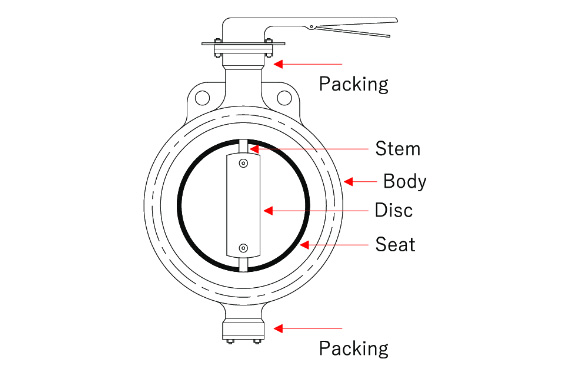
The valve stem, the disc, the valve seat, and the valve body make up the components of the butterfly valve. With only a few parts, the butterfly valve has a simple design and construction.
The Butterfly Valve Body
The valve’s body houses the parts of the valve and can be set between pipe flanges because of its construction. Valve bodies are of two types: wafer type and lug type.
The difference between the two body types is that the lug-type valve body has threads on the outer part of the valve, which allow for attachment with the pipe flanges, while the water-type body type does not have attachments. Instead, bolts are passed through the water-type valve body to allow for joining with the pipe flanges.
The Butterfly Valve Seat
Elastomeric seats are found in many butterfly valves. The valve disc closes into the seat. Proper shutoff of the valve is accomplished because of the interference fit between the disc’s edge and the seat. When the disc closes into the seat, the flow is restricted.
In valves that are not expensive, the butterfly valve seat is usually designed into the body and, if damaged, has to be replaced. But in precision valves, the seats are repairable.
The Butterfly Valve Stem And Disc
The valve’s stem is composed of a one-piece or two-piece shaft design. It can be joined to the valve disc in two ways. The first method involves securing the stem to the disc by the bolts which pass through the disc.
In the second method, the stem is shaped by the disc by floating to locate the middle of the seat.
The disc regulates the flow of media through the valve. The Butterfly valve disc can be designed to fit specific operations, improve flow or enhance sealing operations.
Butterfly Valve Shaft
The valve shaft is connected to the valve disc to ensure transmission of torque from a remote location. The shaft and disc are joined together by a hub which is created on top of the disc. The shaft end is inserted into the hub and forms a connection between the disc and shaft.
How Does The Butterfly Valve Work?
Butterfly valves have different working principles because of their different classifications and types. The manual butterfly valves comprising the hand lever and gear valves operate in a way that is usually suitable for small valves. In contrast, the actuated butterfly valves are usually suitable for larger valves.
Butterfly valves operated by hand levers function with a locking mechanism which controls the stem to allow and restrict flow through the disc. The hand lever operation is easy but unsuitable for larger valves.
Gear-operated butterfly valves operate through a hand-operated wheel that controls the stem to allow and restrict flow through the disc. The gear wheel operation is good for valves larger than the hand lever-operated valves. The gear and hand lever operations are the most common ways of operating butterfly valves.
The actuation methods (Electric, Pneumatic, and Hydraulic) use power in their operations. Large diameter butterfly valves require automated operations to control media flow through the disc. Specific valves are designed to meet the mounting requirements of actuators to ensure the proper functioning of the actuated butterfly valves.
Butterfly valves that function as modulators can be constructed in linear or equal percentage forms.
Butterfly Valves Installation And Maintenance
Installation
Below are some practices that should be considered before installing butterfly valves.
- Space should be made for the disc to open when installed directly into a pump. This can be done with a pipe spacer.
- To install the valve, the flange must be at room temperature.
- While valves can be installed in any form, flat or upright, it is advisable to install them in an upright form. Larger valves require an upright placement to decrease actuator or gearbox weight.
- For smaller valves like the hand lever-operated butterfly valves, any installation orientation can work.
- Welding jobs should be completed before the installation of the butterfly valve.
- Sludges and waste residues in the pipeline must be washed away before the valves are installed.
- The flange and valve should be properly aligned so the disc can open and close without blockages.
- The materials of the butterfly valve components should be checked to ensure no damage was done during transportation or storage.
- The pressure rating of the valve should conform to the requirements.
- The parts of the pipe flanges to contact the valves should be clean and free of residue.
- The butterfly valve should be tested before bolting the flanges to prevent the disc from catching on the pipe.
Maintenance
Below are some essential practices to ensure the butterfly valve works effectively and lasts longer.
- The pressure in the pipes should be released before maintenance of the butterfly valves commence.
- The valve should be lubricated regularly if operations are done in a dry atmosphere.
- The valve should be cycled regularly when not in use.
- The process of removing the valve should occur in reverse of the installation.
What To Consider Before Buying A Butterfly Valve?
Before selecting a valve to buy, various factors should be considered. Butterfly valves are available in different sizes, material types, pressure ratings, standards, and designs. Therefore selecting the butterfly valve suitable for an operation should be based on these factors.
Below, we explain how some of these factors influence butterfly valve selection.
Butterfly Valve Materials
Stainless Steel
Made from Iron, Nickel, and Chromium, stainless steel is insusceptible to rust. Scrapings and scratches are prevented from damaging the valve body because the chromium element in stainless steel prevents rust by forming a preventive layer with oxygen.
PVC
Most butterfly valves are made with PVC. Butterfly valves made with PVC material are not used in high-pressure conditions. These valves, while lightweight, have solid and durable constructions.
Cast Iron
The cast iron material is also commonly used in making butterfly valves. With solid construction and tested durability, these valves function effectively in different conditions. Within the metal family, iron is an economical option for use in making butterfly valves.
Butterfly Valve Standards
For petrochemical industries and piping applications, the following specifications cover the dimensions and tolerances of butterfly valves:
- API 609,
- ASME B16.34 (pressure and temperature rating),
- API 598 (testing),
- ASME B16.5 and
- ASME B16.47 (flanged ends) and
- ASME B16.25
Other industrial butterfly valves are designed with these specifications:
- MSS SP-67
- BS EN 593
- ISO 5752
- MSS SP-68
- AWWA C504
- API 609
Butterfly Valve Design
The butterfly valve designs have been explained above but will be listed here:
- Concentric butterfly valves:
- These are usually applied in operations of wastewater treatments, fire preventive systems, and gas supply systems.
- Eccentric butterfly valves:
- Zero-offset butterfly valves: applied in areas with low pressure and temperature.
- Double eccentric butterfly valves: Usually applied in underground water applications.
- Triple eccentric butterfly valves: applicable in areas with high corrosion, temperature, and pressure.
Butterfly Valve Sizes
Valve size is an important factor to consider in selecting a butterfly valve. In selecting a valve size, here are some areas to look at:
- the type of media the valve will control because the specific gravity and viscosity affect the mediums flow rate,
- Max inlet pressure and temperature and
- Max pressure drop at maximum load,
- Max capacity
- Max pressure drop that the valve will close against.
Butterfly Valve Working Pressure
Operational conditions of butterfly valves are measured in two ways: Body Pressure Rating and Close-off Pressure Rating.
Body Pressure Rating
This explains how pressure the butterfly valve stem and body can withstand without breakage. The ratings vary depending on the manufacturer. Some common ratings are:
- WOG: This is a pressure rating for valves at room temperature.
- Cold Working Pressure (CWP): This is a pressure rating for valves between -20 and -100F.
- Pressure Nominal (PN): This is a PSI rating that some manufacturers include.
Close-off Pressure Rating
This is the maximum differential through the disc that the valve can withstand against the rated seat breakage.
Conclusion
This post discusses all you need to know about the butterfly valve, including its function, parts, installation and maintenance requirements, and what you need to consider before buying an industrial butterfly valve.
Dombor valve is an industrial butterfly valve manufacturer that provides high-quality valve solutions to fit market requirements. With our 20 years of manufacturing experience, we specialise in creating valve types that function in any environment. So contact us today!









